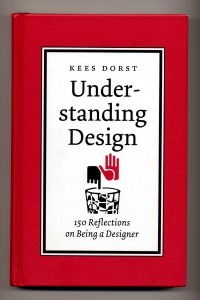Understanding Design
FROM THE VAULT > Book Review originally published in 2006 for the Boston AIGA Journal of Design
Understanding Design: 150 Reflections on Being a Designer
by Kees Dorst, BIS Publishers, Amsterdam © 2003, 208 pages; reprinted by Ginko Press, 2004
It’s not a monograph, it’s not a “best of” anthology, its not an annual. There are no images. Few specific examples. The spine is too stiff. The ink is not black enough. The pages are printed on a slick Kinko’s-like paper that certainly makes “grasping the idea” a challenge as your hands slide off every page like baby powder on a plastic table top.
“When you design, you are actually creating two things in parallel: the design itself and the story behind it.” -p.29
 What does grab you are one hundred and fifty thoughtful one-page essays about D/design. Kees Dorst, a Dutch product designer, design researcher, and philosopher presents us with a collection of his observations about design. Dorst contends design is an activity with diverse outlets and outcomes (buildings, objects, posters) that shares certain intentions and processes, regardless of discipline. Rarely citing his own work, every essay is instead constructed as a general thought-inquiry that requires You the Reader to supply your own experiences in order to prove/disprove his statements. This is an engaging device. While reading these essays and assessing their validity, one begins to ask: “Have I experienced this?” “HOW have I experienced this?” “Should I be experiencing this?” “Should I blame myself or can I blame my job if I have/haven’t experienced this?”
What does grab you are one hundred and fifty thoughtful one-page essays about D/design. Kees Dorst, a Dutch product designer, design researcher, and philosopher presents us with a collection of his observations about design. Dorst contends design is an activity with diverse outlets and outcomes (buildings, objects, posters) that shares certain intentions and processes, regardless of discipline. Rarely citing his own work, every essay is instead constructed as a general thought-inquiry that requires You the Reader to supply your own experiences in order to prove/disprove his statements. This is an engaging device. While reading these essays and assessing their validity, one begins to ask: “Have I experienced this?” “HOW have I experienced this?” “Should I be experiencing this?” “Should I blame myself or can I blame my job if I have/haven’t experienced this?”
Although Dorst claims his primary audience are young designers fresh out of school in need of some practical advice entering the design profession, he also suggests these essays can challenge or reinforce design beliefs for more established professionals.
It should be noted that even though most of what Dorst writes aptly supports or challenges the experience of graphic design, his specific observations when citing graphic design are shaky. He is more successful when he focuses on examples drawn from his own experiences with product design or keeps it general.
“…design options should not just be variations on a single idea. They should be based upon different interpretations of the design problem…” (p. 53)
Overall, the one pages essay format is successful and approachable. They require little time to read and can be encountered in any order. Dorst’s essays often end juicily with statements like: “Design is highly addictive” or “It is strange to realize we are all sinners, some of the time” or my personal favorite “Designers are basically medieval in the way they think.”
The drawback to the one page format is that some ideas can’t be discussed in depth enough to convince the reader of the validity of the author’s opinion. In addition, some of the essays appear fatigued or just slightly more articulate than a rushed journal entry. That does not, however, take away from the overall affect of being challenged to define and expand what Your Experience with design is, theoretically and practically.
Dorst writes calmly and thoughtfully with a balanced voice between ideas and practice. Despite the slippery pages of the actual book, his words do take a hold and linger long after the one page reading experience passes. This book is a good “pick up anytime” volume to coach, challenge, and illuminate your profession.
Leave a Reply